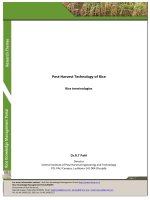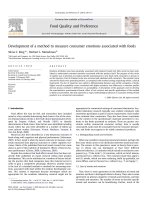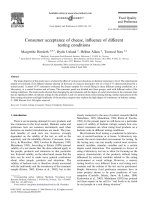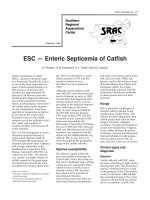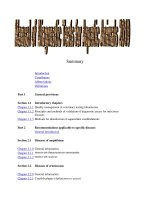Bio-efficacy of tractor operated automatic gun sprayer
Bạn đang xem bản rút gọn của tài liệu. Xem và tải ngay bản đầy đủ của tài liệu tại đây (134.98 KB, 4 trang )
Int.J.Curr.Microbiol.App.Sci (2018) 7(8): 3174-3177
International Journal of Current Microbiology and Applied Sciences
ISSN: 2319-7706 Volume 7 Number 08 (2018)
Journal homepage:
Original Research Article
/>
Bio-Efficacy of Tractor Operated Automatic Gun Sprayer
T. Nageshkumar1*, M. Anantachar1, M. Veerangouda1, K.V. Prakash1,
Sushila Nadagouda2 and B.G. Koppalkar3
1
Department of Farm Machinery and Power Engineering2Department Entomology,
3
Department Agronomy, College of Agricultural Engineering,
UAS, Raichur-584104, Karnataka, India
*Corresponding author
ABSTRACT
Keywords
Pod borer, Insects and
pests, Tractor operated
gun sprayer
Article Info
Accepted:
17 July 2018
Available Online:
10 August 2018
The study was conducted to evaluate the two sprayers for bioefficacy was carried out in
cotton (Bt) and pigeonpea at the farmer’s field, Raichur during 2017-18. The insecticide
used [dinotefuran (osheen)] was solution with a recommended dose 150 g 500 l-1. The
chemical used for spraying the pigeonpea crop was emamectin benzoate (ASTRA). The
chemical was mixed with water at a proportion of 100 g 500 l -1. The insects were reduced
from pre counting as the number of days increased after the spraying. The populations of
aphids were 10, after 5 days reduced to 2.5 numbers. Conventional method of tractor
operated gun spraying recorded higher pod borer population. The overall, present study
concluded that tractor operated automatic sprayer is found to be superior when compared
to conventional gun spraying for the management of pod borer.
Introduction
gross
national
(Manncsa, 2009).
Crop yield is reduced mainly due to attack of
pests, diseases and weeds. In India, crops are
affected by over 200 major pests, 100 plant
diseases, hundreds of weeds and other pests
like nematodes, harmful birds and rodents.
Approximately, 18 per cent of Indian crop
yield potential is being lost due to insects,
diseases and weeds which in terms of quantity
would mean 30 million tonnes of food grain.
The value of total loss estimated at Rs 50,000
million, representing about 18 per cent of the
Cotton crop is concentrated in semi-arid
regions of the country and is one of the
principal commercial crops in India with 9.5
million ha cultivated area which is largest in
the world. Though, India is second largest
producer of cotton in the world, the yield is
only 440 kg ha-1 as against the world average
of 667 kg ha-1 which is due poor control of
insects, pests and dry land farming conditions
(Gholap and Mathur, 2013). Cotton crop is
3174
agriculture
production
Int.J.Curr.Microbiol.App.Sci (2018) 7(8): 3174-3177
infested by various pests. Among the pests of
cotton, cotton bollworms viz., American
bollworm (Helicoverpa armigera), Pink
bollworm (Pectinophora gossypiella) and
spotted bollworms (Earias vitella) cause
significant yield losses (Satyanarayan, 2016).
Cotton is the highest pesticide consuming crop
(36%) followed by rice (20%). About 10 per
cent of insecticides on global basis and 45 per
cent in India are being used for control of
insects in cotton crop alone (Singh, 2004). It is
found that, about 55 per cent of the total
pesticide is being consumed on cotton in India
against 5 per cent of total cultivable land
accounting for 40 per cent of total production
costs (Narang et al., 2015a). In Karnataka,
cotton occupies an area of 4.66 lakh hectare
with a production of 10.15 lakh bales and with
a productivity of 370 kg lint per hectare
(Anon., 2010).
loss in the grain yield under favourable
conditions and damage of seed by pod fly
ranged from 14.3 to 46.6 per cent (Jail et al.,
2014).
The efficacy of insecticides in the insect
management is mainly influenced by the
amount of chemical used in a unit area of
target, deposit of the chemical on the area and
percentage of the target area receiving the
pesticides. The above three factors viz., dose,
distribution and coverage are dependent on the
droplet size and density of the chemical
((Kapasi et al., 2013). Commonly used spray
equipments are conventional tractor operated
gun sprayer and tractor operated automatic
gun sprayer. These sprayers were evaluated
for their effectiveness in reducing pest and
diseases.
Materials and Methods
Red gram (Cajanus cajan millsp.) is an
important pulse crop in India. It is also known
as Pigeonpea, Arhar and Tur. Red gram is
mainly cultivated and consumed in developing
countries of the world including India. India is
the largest producer and consumer of Red
gram in the world and produced 3.17 million
tonne in the year 2014-15 under the area of
3.88 million hectare. Maharastra state is the
largest producer of redgram accounting for
28.83 per cent of total production followed by
Karnataka. In Karnataka state, area under
redgram crop 6.81 lakh hectare with a
production of 4.85 lakh tonnes and
productivity of 712.19 kg ha-1. The red gram
crop is highly susceptible to insect attack. The
pest and disease infection is a serious problem
during the plant growth. Among the many
factors responsible for low yields of pigeonpea
in India, insect, pests are the major ones.
Though the pest spectrum of pigeonpea crop
includes 200 insects and mites, the major
insect causing heavy loss is the pod borer,
Helicoverpa armigera (Hubner) (Kapasi et al.,
2013). Pod borers caused 60 to 90 per cent
The tractor operated automatic gun sprayer
was evaluated its effectiveness against some
of the insects and pests present in the cotton
and pigeonpea. Evaluation of tractor operated
automatic gun sprayer was carried out in
cotton (Bt) and pigeonpea at the farmer’s
field, Raichur during 2017-18. The efficacy of
tractor operated automatic gun sprayer was
carried out at the parameters which are
optimized in the field studies.
Cotton
For calculation of bio-efficacy in the field,
number of pests in the field was counted from
10 randomly selected plants. The pests were
counted from a total of 3 leaves of a plant i.e.
upper and lower side was recorded before and
after the spray leaving the border rows. The
pests count was further recorded on 3rd and 5th
day after spraying. The difference of number
of pests before and after the spray was noted
to calculate the percentage reduction of pests.
The main sucking pests present in cotton were
3175
Int.J.Curr.Microbiol.App.Sci (2018) 7(8): 3174-3177
aphids and leaf hopper. The insecticide used
[dinotefuran (osheen)] was solution with a
recommended dose 150 g 500 l-1.
Pigeonpea
The efficacy of pigeonpea crop was also
measured during the field test. The chemical
used for spraying the pigeonpea crop was
emamectin benzoate (ASTRA). The chemical
was mixed with water at a proportion of 100 g
500 l-1. The major pest recorded was pod borer
Helicoverpa armigera. The efficacy was
measured by taking the number of larva
present a day before spraying and number of
larva present at 3 days and 5 days after
spraying per plant.
At the time of harvest per cent pod damage
was estimated by counting the total number of
pods and the affected pods on five randomly
selected plants in each treatment.
Results and Discussion
The data representing the efficacy of
insecticides and pesticide against insects and
pests is given in the Table 1 and 2. The insects
were reduced from pre counting as the number
of days increased after the spraying. This is
because of the toxic effect of insecticide on
insects.
The leaf hoppers were 5.0 before spraying
reduced to 1.0. In case of T2 (conventional
tractor operated gun sprayer) pre count leaf
hoppers were 6.0 reduced to 2.8 after 5 days
of spraying.
The populations of aphids were 10, after 5
days reduced to 2.5 numbers. Pre counts of
aphids were 13 before spraying in
conventional sprayer reduced to 4.2 numbers.
This shows that automatic sprayers were
effective against cotton sucking pest.
Table.1 Bio-efficacy of spraying against leaf hopper in cotton
Treatment
T1
T2
Population of leaf hopper (No. of hoppers leaf -1)
Pre count
3 DAS
5 DAS
5.0
2.0
1.0
7.0
4.0
2.8
DAS: Days after spraying
Table.2 Bio-efficacy of spraying against aphids in cotton
Treatment
T1
T2
Population of aphids (No. of aphids leaf-1)
Pre count
3 DAS
5 DAS
10
6.5
2.5
13
7.0
4.2
DAS: Days after spraying
Table.3 Bio-efficacy of spraying against Helicoverpa armigera in pigeonpea crop
Treatment
T1
T2
Per cent pod damage
15
18
Population of Helicoverpa armigera (No. of larva plant-1)
DBS
3 DAS
5 DAS
4.2
2.2
0.8
6.0
3.5
2.2
DBS: Day before spraying
DAS: Days after spraying
3176
Int.J.Curr.Microbiol.App.Sci (2018) 7(8): 3174-3177
Bio-efficacy of spraying against Helicoverpa
armigera in pigeonpea crop is presented in
Table 3. It shows that population of
Helicoverpa armigera was 4.2 numbers
reduced to 0.8 numbers after 5 days whereas
in conventional method it was 6.0 number
reduced to 2.2 numbers.
The pod damage by Helicoverpa armigera for
tractor operated automatic gun sprayer and
conventional tractor operated gun sprayer
were 15 and 18 per cent. Conventional
method of tractor operated gun spraying
recorded higher pod borer population. The
overall, present study concluded that tractor
operated automatic sprayer is found to be
superior when compared to conventional gun
spraying for the management of pod borer.
References
Anonymous, 2010, Research highlights.
AICRP. Indian council of Agric. Res.,
p. 5-7
Gholap, B. and Mathur, R., 2013, Field
evaluation of tractor operated boom
sprayer of cotton crop. Int. J. Agric.
Engg., 6(2): 372-374.
Kapasi, M., Yelshetty, S., Mekali, J. and
Haveri, R., 2013, Evaluation of HaNPV
100 LE in different sprayers for
management of pigeonpea pod borer
Helicoverpa armigera (Hubner). J.
Biopest., 6(1): 22-25.
Manncsa, 2009, Pesticides in Agriculture,
Agropedia. p. 265.
Narang, M. K., Mishra, A., Kumar, V.,
Thakur, S. S., Singh, M. and Mishra, P.
K., 2015a, Field evaluation of manual
spraying technology against white flies
on cotton crop in south-west Punjab.
Agric. Engg. Today. 39(1): 229-33.
Satyanarayan, 2016, Design, development and
evaluation of animal drawn intra canopy
sprayer. Unpublished Ph. D Thesis.
Univ. Agric. Sci., Raichur (India).
Singh, 2006, Performance evaluation of air
carrier sprayer for soybean crop. M.
Tech thesis. MPUAT, Udaipur
How to cite this article:
Nageshkumar, T., M. Anantachar, M. Veerangouda, K.V. Prakash, Sushila Nadagouda and
Koppalkar, B.G. 2018. Bio-Efficacy of Tractor Operated Automatic Gun Sprayer.
Int.J.Curr.Microbiol.App.Sci. 7(08): 3174-3177. doi: />
3177
